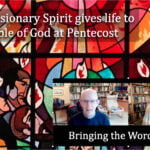My most recent publications are:
- ‘The reimagining of theological time: Revelation’s use of the Old Testament’ in The Scriptures in the Book of Revelation and Apocalyptic Literature.
- ‘The genre of Revelation’ (including two new proposals!) in The Apocalypse of John amongst its Critics.
- The New Testament’s Vision of Mission Grove booklet, exploring key themes from the teaching and practice of Jesus.
- The Practice of Evangelical Spirituality Grove booklet, looking at the seven dimensions of biblical discipleship.
- Exploring the New Testament, Volume Two: Letters and Revelation third edition, fully updated, revised and expanded.
- Revelation: Faithfulness in Testing Times, a series of six studies for individuals or groups.
- Revelation, the Tyndale New Testament Commentary from IVP. (If you order from an online store, make sure you choose mine, not the previous edition by Leon Morris!)
My other recent publications include:
- How to Interpret the Bible: four essential questions (Grove, 2017)
- Being Messy, Being Church (Bible Reading Fellowship, 2017)
- Kingdom, Hope and the End of the World (Grove, 2016)
- The Book of Revelation: currents in British research (Mohr Siebeck, WUNT, 2015)
- Evangelical Leadership: Challenges and Opportunities (Grove, 2016)
What do we do when we worship God?
When I became an Anglican (from a background of a different church tradition), I was at first quite puzzled by the choice of Scripture passages that Anglican (that is, Church of England) services kept coming back to—the Benedictus (Luke 1.68–79) in Morning Prayer, the Magnificat (Luke 1.46–55) in Evening Prayer, and the Nunc Dimittis (Luke 2.29–32) at night. For one thing, all these come from one gospel and one section of that gospel. For another, if you were going to repeat a small number of passages again and again, are there not other passages you would choose first? How about the hymn to love in 1 Cor 13? Or the summary of the gospel in 1 Cor 15? Or the ‘Christ hymn’ of Paul in Phil 2? Or John’s magisterial prologue in John 1? (Of course, most of these do find their way into Anglican liturgy in the form of credal affirmations or canticles.)
It took some time for me to realise the importance of the passages from Luke as programmatic summaries of what God was doing in Jesus: fulfilling the hopes of his people Israel in bringing forgiveness, true liberation and peace (the Benedictus); enacting the Great Reversal of God’s grace over against human pride, following the pattern of Hannah’s prayer in 1 Samuel (the Magnificat); and bringing to completion God’s plan not just for Israel but for the whole world, in anticipation of Jesus’ followers being his witnesses in Jerusalem, Judea and Samaria, and to the ends of the earth (the Nunc Dimittis).
The other passage that puzzled me was the choice of Psalm 95 (also known by its opening words in Latin, pointing back to the influence of the Vulgate translation), the Venite, and its alternative Ps 100, the Jubilate. But it has slowly dawned on me that Ps 95 offers a comprehensive account of what worship involves.
The missionary Spirit poured out at Pentecost in Acts 2
This Sunday is the Feast of Pentecost, when we remember, celebrate, and re-engage with the first giving of the Spirit at Pentecost as recounted in Acts 2., and the lectionary reading in this Year CX is, as every year, Acts 2.1–21. Although it is a comparatively long reading, in one sense it is not long enough, since we do not hear the whole of Peter’s speech, nor do we hear the response to it!
With any of these annual celebrations, we are always confronted with the question of whether there is anything fresh to say. Commentators note that this is one of the most pored over passages in the whole New Testament—and in fact it is laden with theological significance in just about every verse. There are some puzzles which few have solved (and I will offer a solution to one of them!) and of course we need to remember that, whenever we are preaching, there are people listening who might not have reflected on this passage before. And after I had done my reading and preparation for this post, I realised that I had written on this previously—but what I planned was quite different from what I wrote before! So there is hope!
I also found it sobering to work with a different—and older—commentary on this passage, Howard Marshall’s Tyndale Commentary, first published in 1980 but revised in 2008, and given to me as a gift when I started theological study by my sending church in 1990. It is full of insight and application, and I think for that reason has not been replaced in the revision of the series (for which I wrote my commentary on Revelation). I would thoroughly recommend it.
Pentecost is often called ‘the birthday of the church’. Marshall notes (p 67) that the Pentecost narrative occupies the same place in Acts as the birth narrative occupies in Luke’s gospel. But we can go further: there is a striking parallel between the words of Gabriel to Mary, and the words of Jesus to the disciples.
The Spirit poured out at Pentecost in Acts 2 video discussion
This Sunday is the Feast of Pentecost, when we remember, celebrate, and re-engage with the first giving of the Spirit at Pentecost as recounted in Acts 2, and the lectionary reading in this Year A is, as every year, Acts 2.1–21. Although it is a comparatively long reading, in one sense it is not long enough, since we do not hear the whole of Peter’s speech, nor do we hear the response to it!
With any of these annual celebrations, we are always confronted with the question of whether there is anything fresh to say. Commentators note that this is one of the most pored over passages in the whole New Testament—and in fact it is laden with theological significance in just about every verse. Why is the Spirit a sign of the end times? Why are there 17 groups listed by Luke from around the known world? And how does the Spirit equip God’s people for mission?
In the weekly video recorded last year, James and Ian discuss all these issues, including questions about how we preach and teach on this passage. For a full discussion, see the earlier article here.
Seeking a Way Through LLF/PLF: Seeing the Forest Not Just the Trees
Andrew Goddard writes: In dealing with complex questions and decisions it is always important to keep in mind both the big picture of “the forest” and the detailed specifics of “the trees”. Arguably the whole Living in Love and Faith (LLF) process to date has not been particularly good at ensuring this happens.
Three new groups (whose membership has recently been announced) are now setting to work on “the trees” (of standalone services for Prayers of Love and Faith (PLF), the new Pastoral Guidance to replace Issues in Human Sexuality, and the complexities of pastoral reassurance) under the oversight of a new Programme Board chaired by the Archbishop of York. There is the real danger that these will (like their predecessors a year ago and the whole PLF process through 2023) lack the time to step back and discern how all these have to be fitted together. Even doing that is, however, not sufficient. There also needs to be a sense of the much bigger picture of the task and challenges that the Church of England is addressing in relation to these three areas.
This is what the original work on the LLF resources sought to help the church to do. Their concern was to consider the big “forest” questions of identity, sexuality, relationships and marriage. They refused to focus in simply on “the trees” of specific decisions about same-sex relationships and the possible pathways for the church in relation to these. Though this approach was in many ways admirable and necessary, in retrospect, that stage of the LLF process (in giving a guide to the “forest”) was too reticent about addressing what we all knew were the specific major political questions and decisions ahead. Then, when addressing those questions from September 2022 onwards, the bishops jumped to answering the liturgical question without addressing (either adequately or at all) the questions relating to doctrine, pastoral guidance or ecclesiology. In addition, they have rarely if ever explicitly drawn on the work of LLF to explain their approach.
If we return to the fruit of the earlier work on LLF it highlights (at least) two major theological features of “the forest” that must not be ignored or forgotten in the determination now to “reset” the process and broker some sort of “settlement”. Neither of these have been prominent in the discussions thus far but making them more central may help clarify the deeper issues and problems we face and the options between which we have to make a choice. They relate, on the one hand, to questions of ethics and doctrine and, on the other hand, to questions of ecclesiology and development. What follows looks at each in turn and argues that seeking to resolve specific questions (about standalone services, expectations concerning clergy patterns of life, and structural provision) can only be adequately and coherently achieved if these more “big picture” questions are considered first, aided by the earlier work of LLF and lessons from the wider church.
Why is the Ascension of Jesus the most important event in the New Testament?
What would you identify as the climax and completion of Jesus’ life and ministry? Surprisingly, this is not a trivial question. One of the key differences between John and the…
The followers of Jesus are kept, sanctified and sent in John 17
The Sunday lectionary gospel reading for Easter 7 in Year B is John 17.6–19, the central section of Jesus’ so-called ‘High Priestly Prayer’. The reading omits the introduction and opening…
The followers of Jesus are kept, sanctified and sent in John 17 video discussion
The Sunday lectionary gospel reading for Easter 7 in Year B is John 17.6–19, the central section of Jesus’ so-called ‘High Priestly Prayer’. It continues to weave in a range…
Is Critical Race Theory Marxist?
What is the connection between Marxist thinking, Critical Race Theory, and actions by churches (including the Church of England) to address the perceived experience of racial injustice? The question is…
Gender identity and the Christian vision of humanity
Last week, the Catholic bishops of England and Wales issued a pastoral document on the question of gender identity in the light of biblical and theological understandings of what it…
Joy through friendship with Jesus in John 15
The lectionary reading for Easter 6 in Year B is the second half of what appears to be a single section of Jesus’ teaching, in his ‘Farewell Discourse’, John 15.9–17….
Joy through friendship with Jesus in John 15 video discussion
The lectionary reading for Easter 6 in Year B is the second half of what appears to be a single section of Jesus’ teaching, in his ‘Farewell Discourse’, John 15.9–17….



































